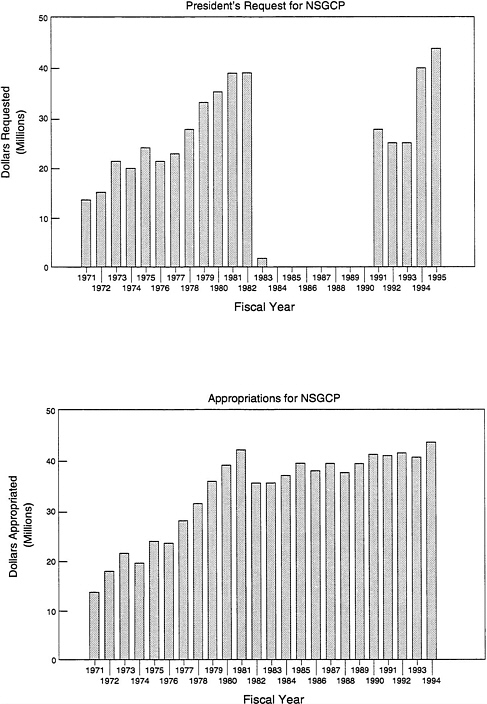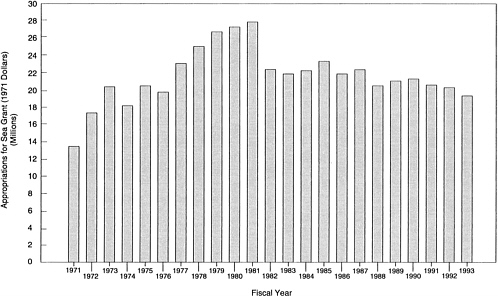1
Introduction
HISTORY OF SEA GRANT
Sea Grant was created by the National Sea Grant College Program Act of 1966 as a marine analog to the Land-Grant College System. Sea Grant was originally placed in the National Science Foundation, which set up a National Sea Grant Office (NSGO) in 1967 and awarded its first grants in 1968. In 1970, Sea Grant was incorporated into the new National Oceanic and Atmospheric Administration (NOAA) with other programs focused on the coastal zone and ocean. The first four Sea Grant Colleges were designated in 1971; today there are 26 Sea Grant Colleges and 3 institutions in the National Sea Grant College Program (NSGCP).
The program steadily received increasing funding until FY1981 (Figure 1).1 From FY1984 to FY1990, Sea Grant was not included in the President 's budget, but was restored by Congress each year. In FY1991 and FY1992, the administration budgeted about $26 million for the program; again, Congress restored the program to level funding of about $40 million. One legacy of these differences in priority between past administrations and Congress is political structures, re-
|
1 |
Figure 1, Figure 2, Figure 4, and Figure 10 were derived from figures that appeared in: National Association of State Universities and Land-Grant Colleges. 1983. The National Sea Grant College Program. A white paper prepared by the NASULGC Board on Oceans and Atmosphere, Washington, D.C. These figures are reproduced with permission from the National Association of State Universities and Land-Grant Colleges. Information for all other figures was provided by the National Sea Grant Office and state program directors. |
lated to state Sea Grant programs, designed to ensure the survival of the program. The FY1994 budget reached a level of $43.2 million, with $3.2 million devoted to marine biotechnology and an additional $2.8 million devoted to zebra mussel work. Although the program has maintained essentially level funding in current dollars over the past decade, the effects of inflation have diminished the purchasing power of the program (Figure 2).
Through Sea Grant, NOAA takes part in a variety of marine and Great Lakes research, education, and outreach activities. Sea Grant has been virtually the only source of funding in the United States for activities in marine policy, and has been a major contributor for the fields of marine aquaculture, coastal and estuarine research, marine fisheries management, seafood safety, marine biotechnology, marine engineering, and marine technology development. Sea Grant combines research, education, and advisory services into coherent, horizontally and vertically integrated approaches for the solution of coastal environmental and commercial problems. It has supported students at all levels of the educational system and has been a major factor in educating a significant portion of marine and Great Lakes scientists who now hold research and policy positions across the United States. Sea Grant supports a unique mechanism for assessing user needs through its local Marine Advisory Service network.
BACKGROUND OF THE STUDY
This study was requested on November 29, 1993, by the Under Secretary of Commerce for Oceans and Atmosphere, Dr. D. James Baker, in preparation for Sea Grant's reauthorization hearings (Appendix 2). Under Secretary Baker requested that the committee report its findings to him by June 1, 1994, because although Sea Grant's existing authorization does not expire until October 1, 1995, congressional hearings are planned for the summer and fall of 1994 and NOAA desires to have ample time to review the recommendations of the committee and to plan for their implementation. The National Research Council approved the composition of the review committee on February 9, 1994, signaling the start of the study.
SCOPE OF THE STUDY AND COMMITTEE COMPOSITION
The charge for the study given in the letter of request was particularly broad, and the following statement of work was developed for the committee:
The Committee to Review the NOAA National Sea Grant College Program will conduct a review and evaluation of the NOAA National Sea Grant College Program for two purposes: to provide the basis for any needed changes in the program, and to provide the basis for NOAA working with Congress on Sea Grant's reauthorization. The review will recognize that Sea Grant is not just a basic ocean science research program; it is a broad, networked aquatic program
designed to address issues and solve problems by combining sciences, social sciences, and the transfer of knowledge and technology.
The committee was formed to provide a balance among the disciplines that Sea Grant funds and between basic and applied science, to reflect the importance of state involvement, and to provide industry and outreach perspectives. Biographies of committee members are given in Appendix 3.
HOW THE STUDY WAS CONDUCTED
Because of the short time available for the study, the committee met in person twice and accomplished the rest of its work by electronic and mail communications. The committee sought input from many sources and evaluated questionnaire responses of state Sea Grant directors, industry representatives, and members of the National Association of Marine Laboratories (Appendix 4). The committee was briefed by participants from all parts of the Sea Grant system and written materials provided by them (Appendix 5)completed the information evaluated by the committee.
As noted above, NOAA requested that the study be conducted in a short period of time. To meet the time constraints, the committee concentrated on six issues that were identified consistently from background documents, from letters received from Sea Grant directors, industry representatives, and NAML member institutions, and from information presented at the committee's meetings. The committee did not evaluate the quality of individual research proposals or of advisory or education activities being carried out by state programs or by NSGO. Such reviews either are now under way within the organization or should be carried out with the appropriate scientific, technical, and relevancy considerations.
The committee's recommendations concern broad cross-cutting issues and are largely addressed to the Under Secretary of Commerce. The committee did not recommend changes in the National Sea Grant College Program Act; however, many changes are requested to be implemented before the 1995 reauthorization process is complete. NOAA should consider these recommendations as it seeks to ensure the future health of the program and to prepare for the reauthorization. The report notes a number of additional topics that NOAA or an appointed independent group should study in more depth in the future. Finally, the committee did not attempt to document the many accomplishments of NSGCP that were reported. This report focuses on areas of the program that need improvement, as requested by the Under Secretary.
The committee concentrated on national-level activities and did not investigate any state programs in detail. Thus, most of the recommendations and findings will concern NSGO; the committee does not wish to imply that many of the state programs would not benefit from changes in their procedures, management,
and focus. It was clear that there is great variability among the 29 programs and there is a shared responsibility among NSGO, Sea Grant institutions, and SGRP to work assiduously to not only achieve uniformity, but more importantly, to increase the average program-wide quality. The committee's recommendations aim to ensure not only an improvement within NOAA, but also an enhancement of the quality at the state level. It is the view of the committee that when such responsibility is recognized and shared, the original goals and current aspirations for the program will be achieved.
ORGANIZATION AND PHILOSOPHY OF THE REPORT
The following two chapters of the report present the critical issues and related findings identified by the committee (Chapter 2) and the recommendations that the committee developed to help Sea Grant and NOAA respond to these issues (Chapter 3). Following the major recommendations, additional subordinate recommendations are discussed.
The committee found that Sea Grant has played an important role in supporting high-quality strategic research of local and national significance and has transferred research results to the industrial and environmental communities. The committee recognized that the present emphasis on strategic research throughout government, which emphasizes links to societal problems and provides economic opportunities to industry, has been the operating philosophy of Sea Grant since its inception. Accordingly, the committee's recommendations suggest ways of improving an important program. It is the unanimous view of the committee that Sea Grant is too important to be allowed to founder. NOAA and the Department of Commerce (DOC) should either recognize Sea Grant's importance to the states and industry or risk the loss of a very visible program. The committee was informed of apathy and hostility toward Sea Grant from many within NOAA and DOC. The committee was surprised by these attitudes given the importance of state-federal partnerships and focused strategic research.








